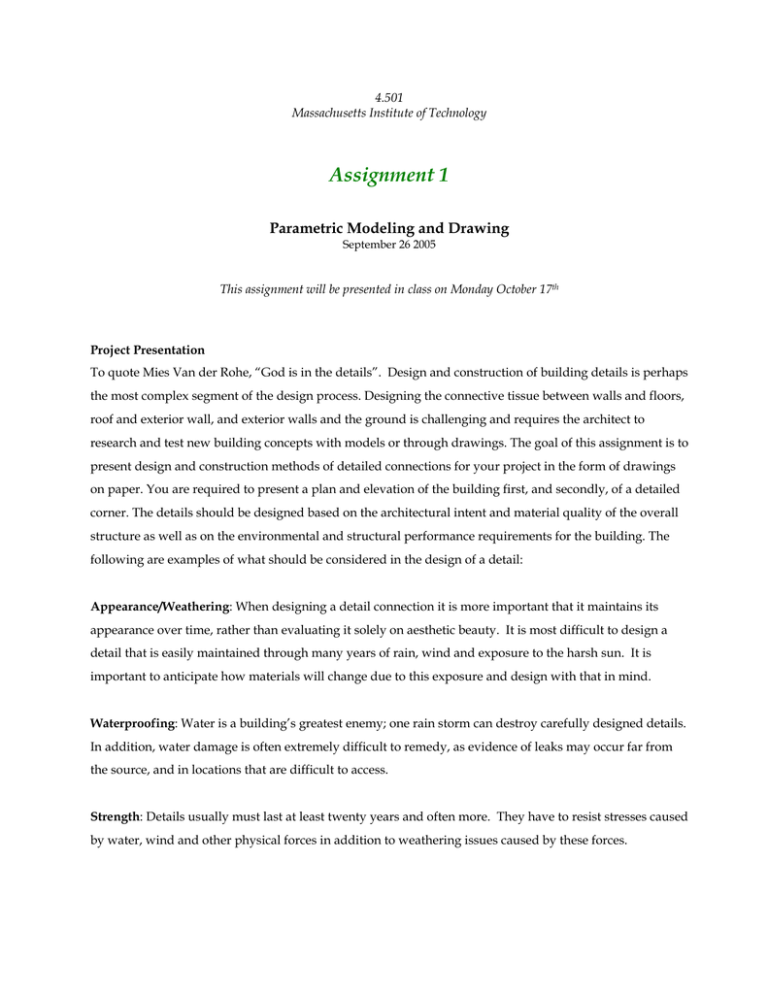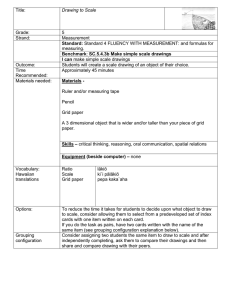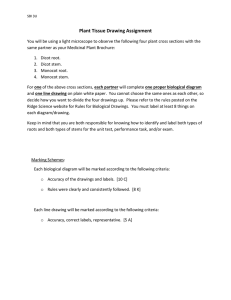Assignment 1 Parametric Modeling and Drawing
advertisement

4.501 Massachusetts Institute of Technology Assignment 1 Parametric Modeling and Drawing September 26 2005 This assignment will be presented in class on Monday October 17th Project Presentation To quote Mies Van der Rohe, “God is in the details”. Design and construction of building details is perhaps the most complex segment of the design process. Designing the connective tissue between walls and floors, roof and exterior wall, and exterior walls and the ground is challenging and requires the architect to research and test new building concepts with models or through drawings. The goal of this assignment is to present design and construction methods of detailed connections for your project in the form of drawings on paper. You are required to present a plan and elevation of the building first, and secondly, of a detailed corner. The details should be designed based on the architectural intent and material quality of the overall structure as well as on the environmental and structural performance requirements for the building. The following are examples of what should be considered in the design of a detail: Appearance/Weathering: When designing a detail connection it is more important that it maintains its appearance over time, rather than evaluating it solely on aesthetic beauty. It is most difficult to design a detail that is easily maintained through many years of rain, wind and exposure to the harsh sun. It is important to anticipate how materials will change due to this exposure and design with that in mind. Waterproofing: Water is a building’s greatest enemy; one rain storm can destroy carefully designed details. In addition, water damage is often extremely difficult to remedy, as evidence of leaks may occur far from the source, and in locations that are difficult to access. Strength: Details usually must last at least twenty years and often more. They have to resist stresses caused by water, wind and other physical forces in addition to weathering issues caused by these forces. Cost: The cost of constructing details is based on the number of trades required at the job site, variations in expensive materials, and the number of components across many trades in the assembly. In short, the greater the number of varying trades, the higher the cost. Assemblies: The right balance of assembly connections between parts should be established. Needed components should have as few connections as possible in order to resist water leaks and complex labor cost. REQUIRED DRAWINGS Page One: Floor Plan @ ¼” = 1’-0” Elevation @ ¼” = 1’-0” Page Two: Axonometric Drawing of the detailed area – the areas should be 10’ x 10’ in plan called out on the floor plan Section dwg: Roof Connection to exterior wall Section dwg: Outer wall with floor Section dwg: Basement and ground plane TEAM MANAGEMENT There are four areas of responsibility granted each team member. It is critical that you all work together to get the project completed and that you are all constructively critical of each other’s role. Output Manager: In charge of 2D printing, laser cutting and CNC routing Master Modeler: In charge of organizing the main file, archiving all project files and combining files for the main model in Digital Project Materials Research: In charge of declaration of materials, library and web research for materials, relationship with the architect and product sale personnel. Designer: In charge of the project appearance and the look of each detail. The designer is also responsible for the overall schedule and assurance that the project goals are met. FIELD WORK Week 1 Field Trip Designing great details comes from experience in both building them and years of observation after the building is constructed. A great builder takes note of details that have not worked over time, corners that leak, colors that fade or assemblies that separate due to building movement. Take notes! Ask questions and learn from the experience of others. Week 2 Designing the Detail First draw a floor plan and elevation in AutoCAD of your project. The drawing should be at ¼” = 1’0” plotted on 24”x36” paper. The drawing will be used by the builder to lay out details and price the project. Make sure to vary line weight and annotate drawings in order to orient the contractor. Second, design the building’s exterior shell while outlining its (1) internal and (2) external material, (3) structure and (4) connections. Week 3 Construction Presentation This drawing is a collection of details in 2D taken from the digital project 3D model. Drawing should include a full section at ½” = 1’0” and called out details at 3” = 1’-0.” As a group you should work together to pull information from various areas of research into one drawing for review by a builder from Empyrean.




